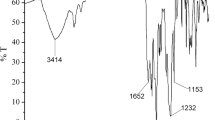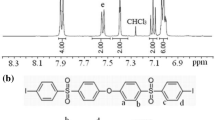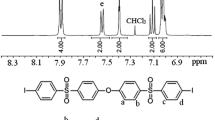Abstract
High molecular weight poly(amide-imide)s containing cardo structures were readily prepared by a supported palladium-catalyzed carbonylation polymerization of diiodo imide monomers, aromatic diamines containing cardo groups, and carbon monoxide. Polycondensation reaction proceeded effectively in N,N-dimethylacetamide (DMAc) at 100 °C in the presence of a bidentate phosphino-modified magnetic nanoparticles-anchored palladium complex [2P-Fe3O4@SiO2-PdCl2] as catalyst and 1,8-diazabicyclo[5,4,0]-7-undecene (DBU) as base under 1 atm of CO, yielding a series of new poly(amide-imide)s with inherent viscosities up to 0.95 dL/g. All the polymers obtained were easily soluble in some strong polar aprotic organic solvents and could be cast into transparent, flexible and tough films from their DMAc solutions. These cardo poly(amide-imide)s displayed high thermal stability with the glass transition temperatures ranging from 237 to 265 °C, the temperatures at 5% weight loss ranging from 433 to 475 °C in nitrogen. These PAI films also exhibited good mechanical behavior and high optical transparency. The present method provides the flexibility of incorporating different ratios of imide and amide groups in the polymer backbone in a controlled manner and eliminates the possibility of postpolymerization curing due to the imide moiety being preformed. Importantly, the supported palladium catalyst can be conveniently separated from the polymer by simply using an external magnetic field and recycled at least 8 times without apparent loss of catalytic efficiency.










Similar content being viewed by others
References
Imai Y (1996) In: Ghosh MK, Mittal KL (eds) Synthesis of polyamideimides in polyimide: fundamentals and applications. Marcel Dekker, New York, pp 49–70
Liaw DJ, Wang KL, Huang YC, Lee KR, Lai JY, Ha CS (2012) Advanced polyimide materials: Syntheses, physical properties and applications. Prog Polym Sci 37:907–974
Ding M (2007) Isomeric polyimides. Prog Polym Sci 32:623–668
Stoakley DM, Clair AKS, Croall CI (1994) Low dielectric, fluorinated polyimide copolymers. J Appl Polym Sci 51:1479–1483
Copeland SD, Seferis JC, Carrega M (1992) Processing of poly(amide imides) as matrices for high-performance composites. J Appl Polym Sci 44:41–53
Dodda MJ, Belsky P (2016) Progress in designing poly(amide imide)s (PAI) in terms of chemical structure, preparation methods and processability. Eur Polym J 84:514–537
Arrington CB, Rau DA, Williams CB, Long TE (2021) UV-assisted direct ink write printing of fully aromatic Poly(amide imide)s: Elucidating the influence of an acrylic scaffold. Polymer 212:123306(1)-123306(8)
Imai Y, Malder NN, Kakimoto M (1985) Synthesis and characterization of aromatic polyamide-imides from 2,5-bis(4-aminophenyl)-3,4-diphenylthiophene and 4-chloroformylphthalic anhydride. J Polym Sci Polym Chem Ed 23:2077–2080
Kakimoto M, Akiyama R, Negi YS, Imai Y (1988) Synthesis and characterization of aromatic polyimide and polyamide-imide from 2,5-bis(4-isocyanatophenyl)-3,4-diphenylthiophene and aromatic tetra- and tricarboxylic acids. J Polym Sci Part A Polym Chem 26:99–105
Ray A, Rao YV, Bhattacharya VK, Maiti S (1983) Syntheis of polyamide-imides containing ether and sulfonamide groups. Polym J 15:169–173
dela Campa JG, De Abajo J, Nieto JL (1982) Aliphatic-aromatic polyamide-imides from diisocyanates, 2. Study of the influence of the reaction conditions on polymer structure. Makromol Chem 183:571–578
Hsiao SH, Yang CP (1991) Preparation of polyamide-imides by direct polycondensation with triphenyl phosphite. V. Aliphatic-aromatic polyamide-imides based on N, N′-bis(ω-carboxyalkyl)benzophenon,3′,4,4′-tetracarboxylic diimides. J Polym Sci Part A Polym Chem 29:447–452
Hsiao SH, Yang CP (1990) Preparation of polyamide-imides via the phosphorylation reaction. II. Synthesis of wholly aromatic polyamide-imides from N-[p-(or m-)carboxyphenyl]trimellitimides and various aromatic diamines. J Polym Sci Part A Polym Chem 28:1149–1159
Yang CP, Wei CS (2001) Synthesis and properties of soluble alternating copoly(amide-imide)s based on 1,2-bis(4-trimellitimidophenoxy)-4-t-butylbenzene and various aromatic diamines. Polymer 42:1837–1848
Wang HM, Hsiao SH (2010) Multicolor electrochromic poly(amide-imide)s with N, N-diphenyl-N′, N′-d-tert-butylpheny,4-phenylenediamine moieties. Polym Chem 1:1013–1023
Li W, Qian X, Shi H, Zhou W, Cai Y, Liu Y, Shen K (2017) Synthesis and properties of novel soluble poly(amide-imide)s with different pendant substituents. J Polym Sci Part A Polym Chem 55:3243–3252
Lee B, Kim SD, Park J, Byun T, Kim SJ, Seo M, Kim SY (2018) Transparent poly(amide-imide)s containing trifluoromethyl groups with high glass transition temperature. J Polym Sci Part A Polym Chem 56:1782–1786
Yoneyama M, Kakimoto M, Imai Y (1988) Novel synthesis of aromatic polyamides by palladium-catalyzed polycondensation of aromatic dibromides, aromatic diamines, and carbon monoxide. Macromolecules 21:1908–1911
Yoneyama M, Kakimoto M, Imai Y (1989) Synthesis of aliphatic-aromatic polyamides by palladium-catalyzed polycondensation of aliphatic diamines, aromatic dibromides, and carbon monoxide. J Polym Sci Part A Polym Chem 27:1985–1991
Turner SR, Perry RJ, Blevins RW (1992) High molecular weight aromatic polyamides from aromatic diiodides and diamines. Macromolecules 25:4819–4820
Perry RJ, Turner SR, Blevins RW (1993) Synthesis of linear, high molecular weight aromatic polyamides by the palladium-catalyzed carbonylation and condensation of aromatic diiodides, diamines, and carbon monoxide. Macromolecules 26:1509–1513
Ueda M, Yokoo T (1994) Synthesis of poly(ether-ketone-amide)s by palladium-catalyzed polycondensation of aromatic dibromides containing ether ketone structure, aromatic diamines, and carbon monoxide. J Polym Sci Part A Polym Chem 32:2065–2071
Ueda M, Yokoo T, Nakamura T (1994) Synthesis of poly(ether-sulfone-amide)s by palladium-catalyzed polycondensation of aromatic dibromides containing ether sulfone structure, aromatic diamines, and carbon monoxide. J Polym Sci Part A Polym Chem 32:2989–2995
Rabani G, Kraft A (2002) Synthesis of poly(ether-esteramide) elastomers by palladium-catalyzed polycondensation of aromatic diiodides with telechelic diamines and carbon monoxide. Macromol Rapid Commun 23:375–379
Perry RJ, Turner SR, Blevins RW (1994) Palladium-catalyzed formation of poly(imide-amides). 1. Reactions with diiodo imides and diamines. Macromolecules 27:4058–4062
Perry RJ, Turner SR, Blevins RW (1995) Palladium-catalyzed formation of poly(imide-amides). 2 Reactions with chloroiodophthalimides and diamines. Macromolecules 28:2607–2610
Krebs FC, Nyberg RB (2004) Influence of residual catalyst on the properties of conjugated polyphenylenevinylene materials: palladium nanoparticles and poor electrical performance. Chem Mater 16:1313–1318
Nielsen KT, Bechgaard K, Krebs FC (2005) Removal of palladium nanoparticles from polymer materials. Macromolecules 38:658–659
Alemdaroglu FE, Alexander SC, Ji D, Prusty DK, Borsch M, Herrmann A (2009) Poly(BODIPY)s: a new class of tunable polymeric dyes. Macromolecules 42:6529–6536
Jiang Y, Okamoto T, Becerril HA, Hong S, Tang ML, Mayer AC, Parmer JE, McGehee MD, Bao Z (2010) Anthradithiophene-containing copolymers for thin-film transistors and photovoltaic cells. Macromolecules 43:6361–6367
Wang D, Astruc D (2014) Fast-growing field of magnetically recyclable nanocatalysts. Chem Rev 114:6949–6985
Baruwati B, Guin D, Manorama SV (2007) Pd on surface-modified NiFe2O4 nanoparticles: A magnetically recoverable catalyst for Suzuki and Heck reaction. Org Lett 9:5377–5380
Jin M-J, Lee D-H (2010) A practical heterogeneous catalyst for the Suzuki, Sonogashira, and Stille coupling reactions of unreactive aryl chlorides. Angew Chem Int Ed 49:1119–1122
Shylesh S, Wang L, Thiel WR (2010) Palladium(II)-phosphine complexes supported on magnetic nanoparticles: filtration-free, recyclable catalysts for Suzuki-Miyaura cross-coupling reactions. Adv Synth Catal 352:425–432
Li P, Wang L, Zhang L, Wang G-W (2012) Magnetic nanoparticles-supported palladium: A highly efficient and reusable catalyst for the Suzuki, Sonogashira, and Heck reactions. Adv Synth Catal 354:1307–1318
Zhang L, Li P, Liu C, Yang J, Wang M, Wang L (2014) A highly efficient and recyclable Fe3O4 magnetic nanoparticle immobilized palladium catalyst for the direct arylation of indoles with arylboronic acids. Catal Sci Technol 4:1979–1988
Tang H, Huang B, Zhu X, Cai M (2018) Synthesis of poly(ether ketone amide)s containing 4-aryl-2,6-diphenylpyridine moieties by a heterogeneous palladium-catalyzed polycondensation of aromatic diiodides, aromatic diamines, and carbon monoxide. Polym Adv Technol 29:2204–2215
Liu L, Zou F, Zhang R, Cai M (2019) Synthesis of new fluorinated aromatic poly(ether ketone amide)s containing cardo structures by a heterogeneous palladium-catalyzed carbonylative polycondensation. Polym Adv Technol 30:58–69
Yang CP, Su YY, Hsu MY (2006) Synthesis and properties of fluorinated polyamides and poly(amide imide)s based on 9,9-bis[4-(4-amino-2-trifluoromethylphenoxy)phenyl]fluorene, aromatic dicarboxylic acids, and various monotrimellitimides and bistrimellitimides. Colloid Polym Sci 284:990–1000
Hu Z, Li S, Zhang C (2007) Synthesis and properties of polyamide-imides containing fluorenyl cardo structure. J Appl Polym Sci 106:2494–2501
Sheng S-R, Ma C-X, Jiang J-W, Li Q, Song C-S (2011) Optically high transparency and light color of organosoluble fluorinated polyamides with bulky xanthene pendent groups. Polym Adv Technol 22:2523–2532
Sheng S, Li T, Jiang J, He W, Song C (2010) Synthesis and properties of novel polyamides containing sulfone-ether linkages and xanthene cardo groups. Polym Int 59:1014–1020
Zou F, Huang B, Liu L, Cai M (2020) Synthesis of cardo poly(arylene ether ketone amide)s by heterogeneous palladium-catalyzed polycondensation of aromatic diiodides, aromatic diamines containing cardo groups and CO. Polym Bull 77:1983–2001
Liaw DJ, Liaw BY, Yu CW (2000) Synthesis and characterization of new soluble cardo polyamide-imides containing cyclododecyl groups. J Polym Sci Part A Polym Chem 38:2787–2793
Acknowledgements
This work was supported by the National Natural Science Foundation of China (Project 21664008) and Key Laboratory of Functional Small Organic Molecule, Ministry of Education (No. KLFS-K01704).
Author information
Authors and Affiliations
Corresponding author
Additional information
Publisher's Note
Springer Nature remains neutral with regard to jurisdictional claims in published maps and institutional affiliations.
Rights and permissions
About this article
Cite this article
Wei, L., Huang, B., Liu, L. et al. Recyclable palladium-catalyzed synthesis of new cardo poly(amide-imide)s from diiodo imides, aromatic diamines containing cardo groups, and carbon monoxide. Polym. Bull. 79, 9523–9541 (2022). https://doi.org/10.1007/s00289-021-03959-5
Received:
Revised:
Accepted:
Published:
Issue Date:
DOI: https://doi.org/10.1007/s00289-021-03959-5




